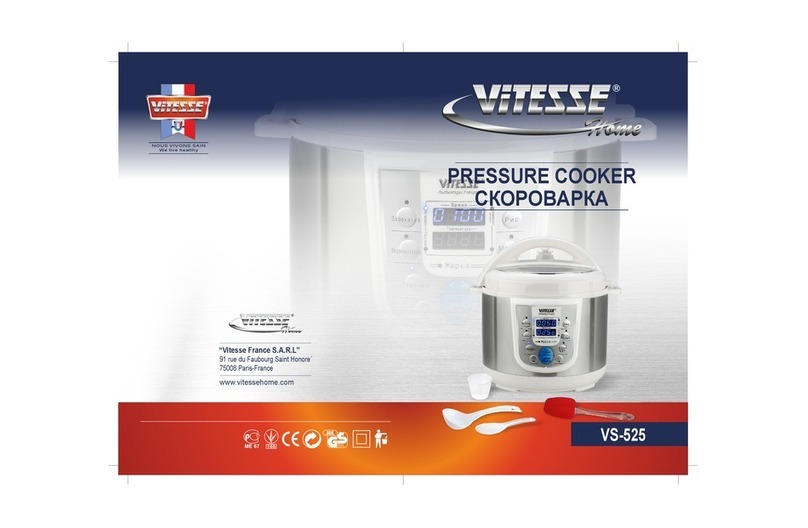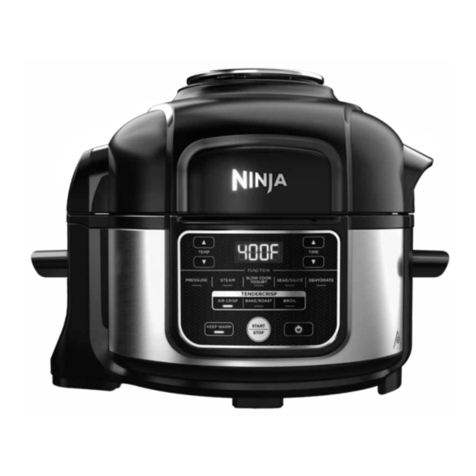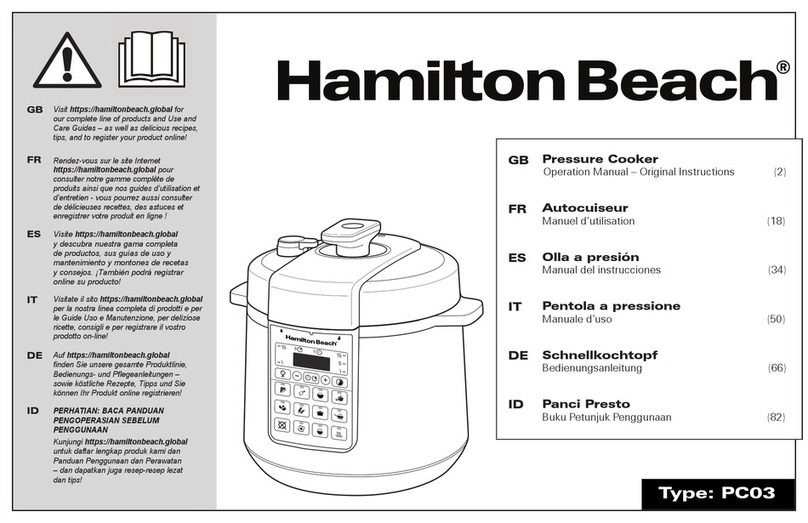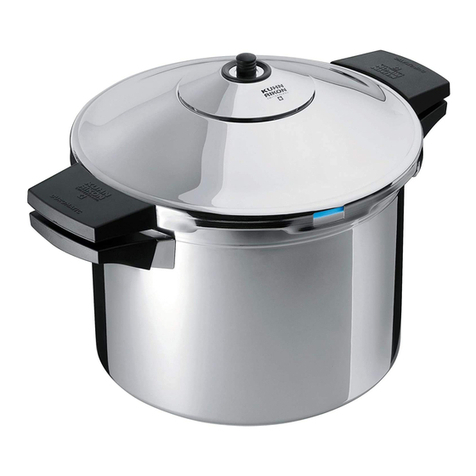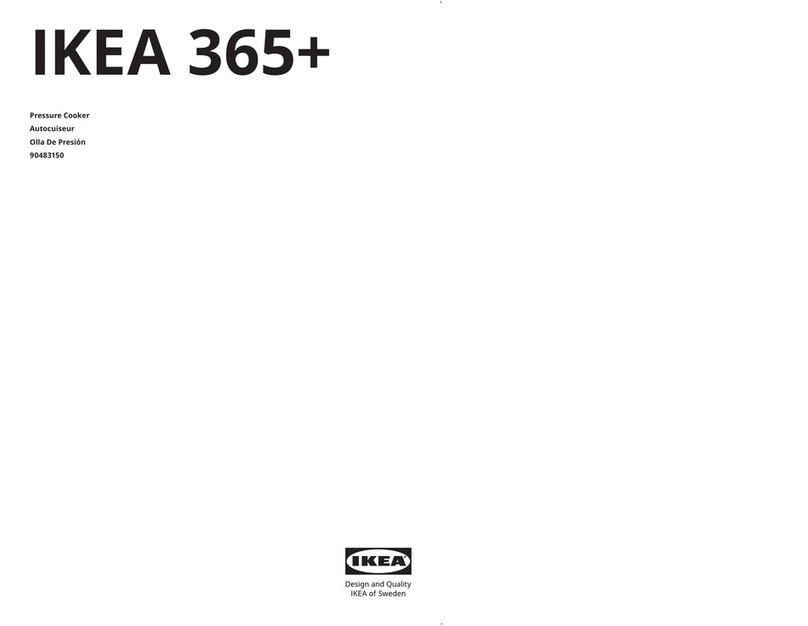Ginnys Y24-12-00 User manual

12QT Aluminum Pressure Cooker
Model# Y24-12-00
Instruction Manual
Important safety instructions: read carefully and keep for future
reference.
www.ginnys.com
This is a UL-listed appliance.Reading the following SAFETY TIPS is strongly recommended
IMPORTANT SAFEGUARDS
To minimize the risk of personal injury or damage to your kitchen,
these safety precautions should always be followed:
1. Read all instructions.
2. Do not touch hot surfaces; use handles or knobs.
3. Close supervision is necessary when the pressure cooker is used near children.
4. Do not place pressure cooker in a heated oven.
5. Extreme caution must be used when moving a pressure cooker containing hot
liquids.
6. Do not use the pressure cooker for anything other than its intended use.
7. This appliance cooks under pressure. Improper use may result in scalding injury.
Make certain the unit is properly closed before operating.See “USING YOUR
PRESSURE COOKER.”.
8. Do not fill over 2/3 full. When cooking foods that expand during cooking such as rice
or dried vegetables, do not fill over 1/2 full . Overfilling may cause a risk of clogging
the vent pipe and developing excess issue. See”COOKING TIMES.”.
9. Do not cook foods such as applesauce,cranberried pear barley,oatmeal or other
cereals, split peas, noodle,macaroni,rhubarb,or spaghetti. These foods tend to foam,
and froth ,and may block the pressure release valve.
10. Always check the pressure release devices for clogging before use.
11. Do not open the pressure cooker until the unit has cooled and all internal pressure
has pressured.If the handles are difficult to separate,this indicates that the cooker is
still pressured-do not force open. Any remaining pressure in the cooker can be
haazardous.
See “USING YOUR PRESSURE COOKER.”
12. Be sure that handles are assembled and fastened properly before each use.
Cracked, broken or charred handles should be replaced.
13. When the normal operation is reached,turn the beat down so all the liquid,which
crates the steam,does not evaporate.
14. Do not use the pressure cooker if it is damaged, or malfunctions. Contact Ginny's
Customer Returns for returning the product, or replacement parts.
15. SAVE THESE INSTRUCTIONS.
THIS PRODUCT IS FOR HOUSEHOLD USE ONLY!
www.ginnys.com

WHAT IS A PRESSURE COOKER?
A pressure cooker is a saucepan with a special lid that locks securely into place
space.As the pressure cooker is heated, the dry air is automatically exhausted and
the moist, heated air is sealed inside,increasing the pressure within the cooker.
When the optimum pressure is reached, internal temkperatures in the cooker are
raised above the normal boiling point of water , causing foods to cook faster. The
higher pressure and temperature speed cooking and tenderize meats naturally.
Before using the pressure cooker for the first time , it is important to become
familiar with the various parts and features of the unit and to read the “USING
YOUR PRESSURE COOKER”section. Here are some of the key components of
the pressure cooker:
GET TO KNOWYOUR PRESSURE COOKER
This pressure cooker is intended for HOUSEHOLD USE ONLY
Discover how fast and easy it is to prepare a wide variety of delicious meals that
focus on good health and nutrition while still tasting great. Designed for today’s fast
paced, health-conscious lifestyle, your pressure cooker is ideal for preparing fast ,
tasty meals designed to keep your family healthy and fit. Pressure-cooking
preserves flavors and nutrients, then derizes meat, and cooks foods three to ten
times faster than other methods.
The PRESSURE REGULATOR ①fits onto the STEAM VENT PIPE ②. When
the proper operating pressure(15 lbs/sq.in.) is reached , the pressure regulator will
rock gently and control the pressure inside the cooker.
The gentle rocking motion of the pressure regulator is an indication that the proper
cooking pressure is being maintained.
The SAFETY LOCK ③automatically releases air from the unit as you begin
heating the pressure cooker. As pressure builds, the safety lock slides up, causing
the LOCK PIN ④to lock the cover place.The safety lock will be in the up position
when the cooker is pressuried. When the safety lock is in the down position, the
unit is depressuried and safe to open.
The SEALING RING ⑥fits around the inside rim of the lid ( see below) and
forms a pressure-tight seal between the LID ⑦and the BODY ⑧of the cooker. If
the vent pipe becomes clogged and excess pressure cannot be released
normally,steam is automatically released by the OVEN PRESSURE PLUG ⑨.
This is a safety device and you should check its condition perodically.
BEFORE FIRST USE
Remove the sealing ring by pulling it out of the inside rim of the lid. Wash the ring,
and body in warm soapy water to remove any packaging material and

manufacturing lubricant. Rinse the ring,lid and body in warm water and dry. When
replacing the sealing ring,be careful to fit it under the stop tabs located on the inside
rim on the lid. The SAFETYVALVE⑩works with the pressure regulator to
release any excess pressure.The VENT STRAINER CAP Can prevent foods
from clogging the steam vent pipe. If SAFETY VALVE and VENT STRAINER fail,
the over pressure plug will pop out and release the excess pressure.
IMPORTANT SAFETY TIPS
Our pressure cooker is designed to prepare delicious,healthy meals in less time than
traditional cooking methods. Used properly, your pressure cooker is one of the
safest appliances in your kitchen. Ensuring safe operation is as easy as following
these simple rules:
1. Do not over filling the pressure cooker.
2. Always visually examine the steam vent pipe to make sure it is clear before
locking the lid in place.
3. Always fully close and lock the lid of the pressure cooker.
4. Never open the cooker when it contains pressure(when the safety lock is in
the up position, there is pessure in the cooker).
5. Replace the overpressure plug when it becomes hard, deformed, cracked,
worn or pitted, or when replacing the sealing ring. Replace the sealing ring
when it becomes hard.
Understanding these instructions is important So that you understand why these
instructions must be followed every time you use the cooker, please read the
following:
1. Never overfill the pressure cooker.
If the cooker is overfilled, this may cause the pressure relief services to stop
functioning properly.The pressure regulator is designed to maintain safe cooking
pressures. It relieves excess pressure through the vent pipe as it rocks back and
forth.The overpressure plug is a backup pressure relief valve designed to release
excess pressure if the pressure regulator fails to operate properly. Neither one can
perform their function if there are obstructions in the other. Obstructions can occur
if the pressure cooker is overfilled. For most foods, it is safe to fill the pressure
cooker up to 2/3 full.There are a few foods that expand to the point that the pressure
cooker should never be more than 1/2 full when cooking them.These are also foods
that,because of the foaming,and frothing that occur during cooking.Should never be
pressure-cooked.The pressure cooker is marked at the 1/2 and 2/3 full levels so that
you always know how much liquid is in the unit.
Be sure to not let any of the foods you are cooking extend above the maximum fill
level (Fig.C)
2. Visually examine the steam vent pipe for obstructions before using the
cooker.
To examine the steam vent, unscrew the pressure regulator (Fig.A#1) on the top of
the lid. Next turn over the lid and gently remove the strainer cover from the base of
the vent(Fig.D1 and D2). Hold the lid up to a light to confirm that the vent is clear
of any obstruction. If the steam vent pipe is blocked , remove the obstruction before
using the cooker. Replace the strainer cover before using the unit. Failure to remove
an obstruction from the steam vent will result in pressure building to unsafe levels.
3. Always fully lock the lid of the unit.
The lid handles must be aligned directly over the body handles. The specially
designed lugs in the lid are designed to lock in place when the lid is properly closed.
However,if the lid is not properly seal, the lugs will not lock the lid onto the body. It
is possible that pressure may build inside the cooker and cause the cover to come
off, possibly resulting in bodily injury or property damage.
4. Never open the cooker when it is pressurized.
Opening the pressure cooker while it is pressurized will cause the contents of the
cooker to erupt which could cause bodily injury or property damage.
5. Replace the overpressure plug and the sealing ring.
Replace if they become hard, deformed, cracked, worn, pitted, or soft and sticky; or
every two years; whichever occurs first. Always replace the overpressure plug when
replacing the sealing ring.The overpressure plug is a backup pressure relief valve,
and is designed to relieve excess pressure from the cooker cover in the event that
the vent pipe should become blocked. The ovepressure plug is made of rubber. Over
time, depending the frequency and type of use, rubber becomes hard and inflexible,
loses its ability to act as a backup pressure relief valve, and should thus be replaced
immediately. Frequent contact with oily foods will cause the sealing ring to
deteriorate. Deterioration will result in the ring becoming either hard and inflexible
or soft and tacky. Should this occur, immediately replace the ring, as failure to do so
could result in pressure release, causing great bodily harm and / or property damage.
Do not apply cooking oil to the sealing ring.

USINGYOUR PRESSURE COOKER
Having familiarized yourself with the components of the unit and their purposes, it
is important that you read the following information about pressure-cooking and the
step-by-step instructions before you begin to cook.
Pressure cookers create moist heat under pressure to cook the food, because the
cooking process is done in a sealed vessel, very little liquid is lost. Hence, you will
need only about 8 oz. more liquid than is needed for the finished dish. You can
achieve the best results by following these simple step-by –step instructions:
1. Prepare your ingredients using the recipe you have selected.
2. If you are cooking vegetables, soups or desserts, skip to step.
3. Many meat and poultry recipes call for brown the meat or poultry before
cooking. To brown the meat or poultry using your pressure cooker, preheat the
uncovered pressure cooker, being careful not to overheat the cooker. Pour the
required amount of cooking oil called for in the recipe into the cooker.
CAUTION: Pouring cooking oil into an overheated pan could cause the oil to
ignite.
4. Put the meat or poultry in cooker and sear thoroughly on all sides until it is
deep brown and crisp. Monitor the heat to prevent burning. Season. Less
seasoning may be required, as foods cooked in a pressure cooker retain more of
their natural flavor. Remove pressure cooker from heat and allow it to cool
slightly before adding liquid to the unit.
5. Pour the amount of liquid called for in the recipe into the pressure cooker.
Handy Tip: When preparing more than one item at a time, make sure that the items
being prepared have the same cooking times and temperatures.
6. To lock the lid in place, align the “V” mark on the lid with the arrow on the body
handle. Rotate the lid until the cover drops into position. Lock the lid in place by
rotating it clockwise until the lid handle is aligned with the body handle. The
pressure cooker lid is properly locked in place when the lid handles are directly
above the body handles. DO NOT OVER-ROTATE THE LID(Fig F and Fig G).
7. Place the pressure regulator in the vent pipe, screwing it in until it moves down
no further. The pressure regulator will fit loosely on the vent pipe. It will not touch
the top of the pressure cooker cover.
8. Heat the pressure cooker until the pressure regulator begins a gentle rocking
motion. A medium to high heat setting is best. The safety lock will move up and
down, releasing dry air and a little steam. Once the cooker has reached its operating
pressure and temperature, the safety lock will seal and remain in the up position
until the pressure is released. The overpressure plug will rise slightly and seal as
well.
9. Calculate cooking times when the pressure regulator begins to rock gently.
Gradually lower the heat to maintain a slow, steady rocking motion. Cook for time

indicated in the recipe or cooking chart. When cooking is complete, remove
pressure cooker from burner and allow it to cool.
Handy Tip: If the pressure regulator is allowed to rock vigorously, excess steam
will escape, too much liquid will evaporate, and the food will burn.
10. Pressure should be reduced in accordance with the recipe or the cooking chart
instructions. If the receipe or chart requires that the cooker cool naturally, then set
the pressure cooker aside. You will know this has occurred when the safety lock has
dropped below the top of the handle.
11. After pressure has been completely reduced, remove the pressure regulator.
Always remove the regulator before opening the cover.
12. To open the cover, turn it counter clockwise until the arrow on the body handle
aligns with the “V”on the cover. Then lift the cover toward yourself to keep any
steam away from you. If you have difficulty in rotating the cover, there is still some
pressure in the unit. Do not force the cover off. Continue to cool the cooker until
the safety lock has dropped, and cover will turn easily.
13. This appliance cooks under pressure. Improper use may result in scalding injury.
Make certain unit is properly closed before operation.
14. Do not open the pressure cooker until the unit has cooled and all internal
pressure has been released. If the handles are difficult to push apart, this indicates
that the cooker is still pressurized do not force open. Any pressure in the cooker can
be hazardous.
16. Food is ready to serve.
HOW TO CLEAN YOUR PRESSURE COOKER
1. Your pressure cooker and all of its components are fully submersible for easy
cleanup. Always remove the sealing ring to ensure thorough cleaning of the
inside rim of the lid. The sealing ring should be washed with hot, soapy water
after each use. Remove the safety valve in the pressure cooker cover handle for
cleaning. To remove the safety valve, turn the lid over and unscrew the cover
handle with a small brush. After cleaning, rinse the spring and metal shaft of
the safety valve and thread gently into place. Be careful nott to over torque the
valve.
2. The overpressure plug can also be removed for cleaning by pushing it out of its
opening from the top of the cover. After cleaning, reinsert it by pushing the domed
side of the plug into the opening from the underside of the cover, until the bottom
edge is fully and evenly seated against the underside of the cover (Fig.H).
3. Clean the steam vent pipe with a small brush or pipe cleaner (Fig I). To clean
the vent pipe, unscrew the pressure regulator (Fig. A#1) on the top of the lid.
4. Minerals in water and foods may darken the inside of your cooker. This
discoloration will not affect the food cooked in the unit. Mineral stains can be
removed by using a solution of water and cream of tartar. Use a tablespoon of
cream of tartar for each quart of water. Dissolve the cream of tartar in the water
and pour enough solution into the cooker to cover the discoloration (do not fill
over 2/3 full). Lock the lid in place, put the pressure regulator on the vent pipe,
and heat unil the presure regulator rocks gently. Remove the cooker from the
heat and allow it to stand form tow to three hours. Remove the pressure
regulator and discard the contents. Scour thoroughtly with a scrubbing pad;
wash, rinse, and dry.
5. Hand wash only a mild detergent. If food residue adheres to the body of the
pressure cooker, use a non-metal bristled brush for removal.
6. When not in use, store your pressure cooker in a dry place with the cover
inverted on the body. If the cover is locked on, the sealing ring could be
damaged.
7. Avoid striking the rim of the pressure cooker body with metal cooking utensils,
as this could cause nicks in the rim and prevent the pressure cooker lid from
forming a proper seal.
8. If the handles loosen, tighten them with a screwdriver, but do not over tighten
the screws.
9. Leakage between the cover and body is usually cause by shrinkage of the
sealing ring after prolonged use. Replace the overpressure plug as well. Do not
apply cooking oil to sealing ring.

10. The formation of a small amount of moisture
under the pressure regulator is normal when cooking
first begins; however, it should stop when pressure
begins to build and the overpressure plug and safety lock seals. If leakage continues,
clean or replace the overpressure plug and safety lock assembly. If the pressure
cooker still fails to seal, the gasket from the safety lock may be cracked.
TIPS & HINTS
Your favorite recipes may be adjusted for use in your pressure cooker by following
the cooking chart in this book for the food being prepared. Generally, you can
reduce the cooking time for your recipe by 2/3, since pressure-cooking is much
faster than other cooking methods. For example, if your ordinary cooking method
requires 60 minutes, in the pressure cooker, cooking item will be reduced to 20
minutes. Because there is very little evaporation, the amount of liquid used should
be decreased. Use about 8 oz. more liquid than desired in your finished dish. There
are many different liquids that can be used in a pressure cooker; wine, beer,
bouillon, fruit juices, and water all work excellently. Remember, there must always
be water or some other liquid in the pressure cooker to produce the necessary
amount of steam.
If a pressure cooker recipe or the cooking chart requires a cooking time of 0
minutes, cook the food only until the pressure regulator begins to rock. Remove the
pressure cooker from the heat source and cool according to the recipe. For dilicate
foods such as custards, fresh vegetables, and serving-size pieces of meat,
immediately cool the cooker. For roasts and stew, let the pressure drop of its own
accord.
When cooking at high altitudes, the cooking time needs to be increased 5% for
every 1000 feet above the first 2000 feet. Times should be adjusted as follows:
Because pressure-cooking times are increased at altitudes above 2000 feet,
additional cooking liquid will be needed.
FREQUENTLYASKED QUESTIONS
The lid is hard to open or close.
The locking lid on your pressure cooker is designed to create an airtight seal. If you
find that the lid becomes difficult to open or close, follow these suggestions:
Hard to close: Press the palm of you hand on the cover area directly opposite the
cover handle while moving the cover handle to the closed position with your other
hand. After brazing meat or poultry, the cover may be difficult to closed due to
expansion of the pressure cooker body from heating. Allow the presssure cooker
body to cool slightly and try again.
Hard to Open: Generally, the only reason for the lid to be hard to open is that there
is still pressure built up in the cooker. Allow the cooker to continue to cool until the
lid is easily opened.
Helpful Hint: To help make the lid easier to open
and close, a very light application of cooking oil
may be applied to the bottom of the lugs on the
pressure cooker body(Fig.J). Using a pastry brush,
piece of cloth, or your fingertips, apply a small
amount of oil to the lugs, making sure to remove
any excess. Never apply cooking oil to the sealing ring.
There is more liquid in the pressure cooker than
I want.
Reduce over low heat to evaporate the excess liquid.
How do I prevent overcooking?
Accurate timing is essential to preparing a great meal. Always remember to begin
the cooking time when the pressure regulator has begun to gently rock. Using a
kitchen timer will help to ensure that the cooking time is correct. Be sure to follow
the recipe instructions for cooling the pressure cooker, as the food will continue to
cook during the cool down period.
What if the food is not completely done after the recommended cooking time?
Simply bring the cooker back up to pressure and cook the food a minute or two
longer.
How do I know my pressure cooker is operating properly?
The rocking pressure regulator provides both a visual and audible indicator that
your cooker is functioning correctly.
What kind of range is best for pressure-cooking?
Your pressure cooker is very energy-efficient and will work on all stoves and range
tops with the exception of induction ranges.
When cooking first begins, is it normal for steam to escape and moisture to
form on the cover and between the handles?
Yes. However, if steam continues to vent around the handles and /or cover, the lid
may not be fully locked onto the body.

The safety lock rises partially and then drops back down when cooking first
begins ?
The safety lock will move up and down slightly when cooking first begins. The
safety lock should remain in the up position once the cooker has sealed. If the
safety lock continues to move up and down or rises only partially, tap it lightly with
the tip of a knife. If safety lock does not rise and seal, check the following:
1. The range is not hot enough.
2. The cooker is not fully sealed.
3. There is not enough liquid to form steam.
4. The gasket for the safety lock needs to be replaced.
COOKINGTIMES
Processing time at 15 pound, as given in this chart, apply only to altitudes up to
3,000 feet. For Higher altitudes please see Tips & Hints section.
Do not fill the unit over 2/3 full. Overfilling may cause a risk of clogging the vent
pipe and developing excess pressure.
MEATS & POULTRY
It is best to brown or sear meats and poultry prior to adding liquid for the
pressure-cooking process This will help to lock in flavor. Use a small bit of cooking
oil to prevent the foods from sticking.
All roasts listed below refer to a 3 lb.size. Roast do not require cooling the cooker
after the prescribed cooking time. However, on cut pieces of meat or poultry,
always cool the cooker to avoid overcooking.
FRESH VEGETABLES
When using the following cooking times, choose the lowest number for a crisper
consistency, and the highest number for softer vegetables. Always cool the cooker,
as described on before to avoid overcooking.
DRIED VEGETABLES
All of the items below MUST be presoaked to avoid foaming during the cooking
process. All cooking times relate to two cups of the dried vegetables. To presoak.
Add 1-2 tbsp cooking oil, one tablespoon of salt, and cover completely with water.
Soak overnight, or for at least eight hours.
Drain, and recover with clear water.
SEAFOOD
All of the following seafood items require one cup of liquid for pressure-cooking.
Always cool the cooker, as described on before to avoid overcooking.

CEREALS
For rice and corn meal, ingredients MUST be added to boiling water prior to
placing the lid on the pressure cooker. Stir well. All of the items below are based on
1 cup. If doubing the receipe, also double the liquid required.
DO NOT FILL OVER THE PRESSURE COOKER’S CAPACITY.
1 YEAR LIMITED WARRANTY
Ginny’s warrants this product free from defects in material and workmanship for one year
from provable date of purchase.
Within this warranty period, Ginny’s will repair or replace, at its option, defective parts at
no charge, provided the product is returned, freight prepaid with proof of purchase to
Ginny’s. Allow 2-4 weeks for return shipping.
This warranty does not cover improper installation, misuse, abuse or neglect on part of
the owner. Warranty is also invalid in any case that the product is taken apart or
serviced by an unauthorized service station.
This warranty gives you specific legal rights and they may vary from state to state.
THE FOREGOING WARRANTIES ARE IN LIEU OF ALL OTHER WARRANTIES AND
CONDITIONS, EXPRESS OR IMPLIED, INCLUDING BUT NOT LIMITED TO THOSE OF
MERCHANTIBILITY OR FITNESS FOR A PARTICULAR PURPOSE.
GINNY’S Customer Returns
Phone: 800-991-4442
8:00 am to Midnight, Monday through Friday
www.ginnys.com
Table of contents
Other Ginnys Electric Pressure Cooker manuals

